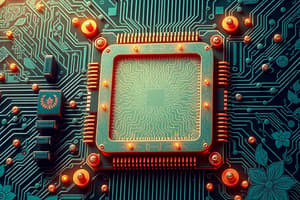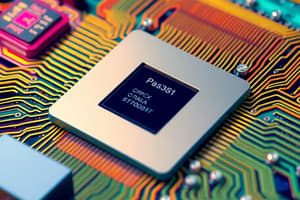Podcast
Questions and Answers
What does clock speed measure in a computer system?
What does clock speed measure in a computer system?
- Speed of cache memory access
- Data transfer rate between components
- Amount of installed memory
- Frequency of CPU cycles per second (correct)
Which type of computer is specifically designed for complex tasks such as design or scientific computations?
Which type of computer is specifically designed for complex tasks such as design or scientific computations?
- Server
- Workstation (correct)
- Personal Computer
- Embedded System
What does Moore's Law describe?
What does Moore's Law describe?
- Velocity of data across the data bus
- Double the data transfer rate each year
- Increasing RAM capacity with each new model
- Doubling the number of transistors on integrated circuits every two years (correct)
Which of the following is an example of specialized hardware?
Which of the following is an example of specialized hardware?
What is the primary purpose of cache memory in a computer system?
What is the primary purpose of cache memory in a computer system?
What is the role of the Arithmetic Logic Unit (ALU) in the CPU?
What is the role of the Arithmetic Logic Unit (ALU) in the CPU?
Which of the following statements accurately describes RAM?
Which of the following statements accurately describes RAM?
In the instruction cycle, what occurs during the 'Decode' phase?
In the instruction cycle, what occurs during the 'Decode' phase?
Which of the following best defines secondary storage?
Which of the following best defines secondary storage?
What distinguishes Harvard architecture from Von Neumann architecture?
What distinguishes Harvard architecture from Von Neumann architecture?
What is the primary function of an Operating System (OS)?
What is the primary function of an Operating System (OS)?
What is the primary purpose of device drivers?
What is the primary purpose of device drivers?
Which component is responsible for communicating between different parts of a computer system?
Which component is responsible for communicating between different parts of a computer system?
Flashcards
Clock Speed
Clock Speed
The frequency at which a CPU performs operations, measured in Hertz.
Cache Memory
Cache Memory
Fast memory near the CPU that stores frequently used data, making access quicker.
Motherboard
Motherboard
The main circuit board connecting all computer components.
Moore's Law
Moore's Law
Signup and view all the flashcards
Workstation
Workstation
Signup and view all the flashcards
CPU
CPU
Signup and view all the flashcards
RAM
RAM
Signup and view all the flashcards
Secondary Storage
Secondary Storage
Signup and view all the flashcards
Input Device
Input Device
Signup and view all the flashcards
Operating System (OS)
Operating System (OS)
Signup and view all the flashcards
Von Neumann Architecture
Von Neumann Architecture
Signup and view all the flashcards
Fetch-Decode-Execute Cycle
Fetch-Decode-Execute Cycle
Signup and view all the flashcards
Instruction Cycle
Instruction Cycle
Signup and view all the flashcards
Study Notes
Computer System Architecture
- A computer system is a complex collection of components working together to execute instructions.
- It comprises hardware (physical components) and software (programs).
- The fundamental structure often involves input, processing, output, and storage units.
Key Hardware Components
- Central Processing Unit (CPU): The brain of the computer; executes instructions.
- Consists of Arithmetic Logic Unit (ALU) for calculations and Control Unit (CU) for coordinating operations.
- Speed measured in gigahertz (GHz).
- Memory (RAM): Stores data and instructions currently being used by the CPU.
- Volatile—data lost when power is off.
- Fast access speeds compared to secondary storage.
- Secondary Storage: Stores data and programs persistently (even when the computer is off).
- Examples: hard disk drives (HDDs), solid-state drives (SSDs).
- Slower access times than RAM, but higher storage capacity.
- Input Devices: Allow users to provide data to the computer.
- Examples: keyboard, mouse, scanner, microphone.
- Output Devices: Present processed data to the user.
- Examples: monitor, printer, speakers.
- Buses: Communication channels that connect different components.
- Transfer data between CPU, memory, and other components.
- Different types transmit data at variable speeds and in different formats.
System Software
- Operating System (OS): Manages hardware and software resources.
- Examples: Windows, macOS, Linux.
- Facilitates interaction between applications and hardware.
- Utility Programs: Perform specific tasks like file management, disk cleanup, and system optimization.
- Assist in streamlining system functions.
- Device Drivers: Allow the OS to communicate with specific hardware devices.
- Ensure proper functioning of peripherals.
- Enable the OS to handle different types of input/output.
Instruction Cycle
- CPU follows a cycle to execute instructions.
- Fetch: Retrieves an instruction from memory.
- Decode: Interprets the instruction's meaning.
- Execute: Performs the specified operation.
- Store: Stores the results to memory or registers.
Computer System Organization
- Von Neumann Architecture: Instructions and data stored in the same memory.
- Common approach, although modifications and variations exist.
- Harvard Architecture: Separate memories for instructions and data.
- Allows simultaneous access, potentially increasing processing speed.
System Performance Factors
- Clock Speed: Measures the frequency of CPU cycles per second.
- Cache Memory: Small, very fast memory that stores frequently accessed data.
- Memory Bandwidth: The rate at which data can be transferred to and from memory.
- Bus Speed: The transfer rate of data across buses.
Interconnections
- Motherboard: Connects all the components of a computer.
- Contains slots and sockets for various components.
- Defines how components interact.
Types of Computers
- Personal Computers (PCs): Designed for individual use, varying in size and capabilities.
- Workstations: More powerful PCs, typically used for demanding tasks such as design or scientific computations.
- Servers: Provide resources to multiple users and applications.
- Embedded Systems: Designed for specific tasks, often integrated into larger devices.
- Examples: control systems in cars, appliances, and industrial machinery.
Trends in Computer Systems
- Moore's Law: Observation that the number of transistors on integrated circuits doubles approximately every two years.
- Reflects ongoing miniaturization in hardware design.
- Cloud Computing: Access computing resources and services over a network.
- Parallel Processing: Utilizing multiple processors to perform tasks simultaneously.
- Specialized Hardware: GPUs, FPGAs, for specific domains like graphics and parallel computations.
Studying That Suits You
Use AI to generate personalized quizzes and flashcards to suit your learning preferences.




